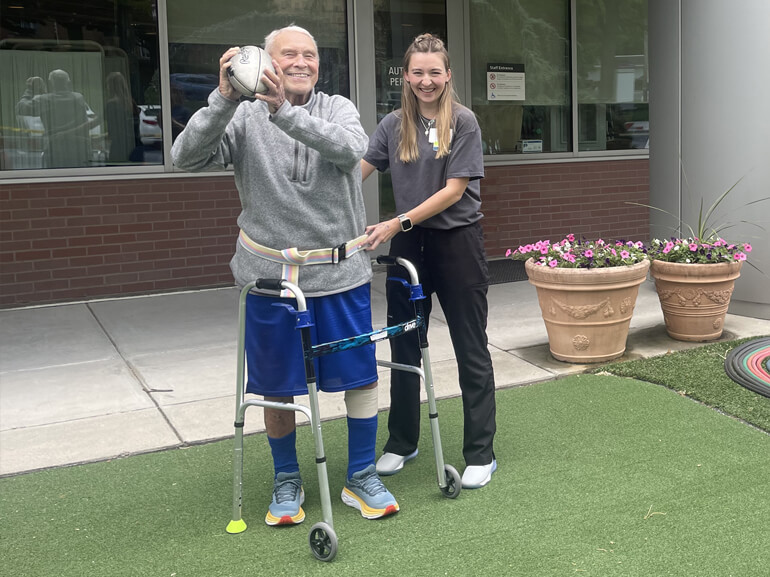James' story

James “Coach ” Sauve has athleticism in his blood. A standout three-sport athlete in high school, he excelled in football, wrestling and baseball. Coach continued his athletic pursuits at West Chester University, where he played football and wrestled. He went on to coach both sports at prestigious institutions including West Point, the University of Maryland and Gettysburg College. Athletics was not just a passion for Coach; it became a way of life for him and his family.
Together with his wife, Judy, they raised four boys, all of whom inherited their dad’s athleticism and work ethic. Following in his footsteps, his sons became collegiate athletes, and now, even his grandchildren carry on the family’s athletic legacy. Retired from a successful career in the insurance industry, Coach, now 80, was still up for the game of life. But an unexpected incident occurred during a snorkeling trip with his family in Mexico. While snorkeling, Coach scraped a scabbed area on his leg against some rocks. Alarmingly, when the family returned to the states the following morning, he was having difficulty walking and showing signs of delirium. Suspecting a stroke, his family rushed him to UPMC West Shore Hospital for evaluation.
However, test results surfaced something different: Coach had a severe infection caused by the flesh-eating bacteria Vibrio. Swift action was needed, and an operation to remove
the infected skin from his lower left leg was performed to halt the spread of the infection. For three days, Coach relied on a ventilator, and after the surgery, he needed a wound vacuum on his leg to aid in healing. To ensure the best possible care and recovery, Coach was subsequently transferred to Select Specialty Hospital – Harrisburg. Here, a team of expert nurses, therapists and
clinical staff devised a comprehensive care and treatment plan tailored to Coach’s needs. Addressing his wound care, the team ensured cleanliness and proper dressing while managing his associated pain. Administering IV antibiotics became essential to flush out the infection and protect against any recurrence. Additionally, diuretics were administered to counter fluid retention in his body.
After 16 days of intense care at Select Specialty Hospital, Coach’s recovery progressed to the point where he was ready for the next phase: rehabilitation at Helen M. Simpson
Rehabilitation Hospital. When he arrived, he required the assistance of two people to stand. Physical therapy (PT ) focused on improving his balance, incorporating range of motion exercises to strengthen his joints. Occupational therapy (OT) introduced tasks involving grasping and carrying weighted items during walking practice, enhancing his focus and multitasking abilities. They also worked on his recall abilities by engaging him in multi-step activities of daily living such as personal grooming routines.
By day 18, Coach had made strides in his recovery, though significant pain persisted when attempting to put weight on his left leg due to the continued need for the wound vacuum. Despite the challenges, he managed to walk 20 feet with a walker and support for balance. Upon discharge from Helen M. Simpson Rehabilitation Hospital, Coach returned home with a wheelchair, a
walker and additional assistive equipment. His devoted family was there every step of the way. Son Jeremey worked from Coach’s home during the day to help out, while brothers Jeff and Jon lent support overnight. Coach’s loving wife Judy was always by his side.
As he continued his home therapy, Coach faced another hurdle: the pain in his left leg was hampering his progress. His medical team scheduled a skin graft procedure at UPMC West Shore Hospital as the next step in his treatment plan. Following the surgery, Coach returned to Helen M. Simpson Rehabilitation Hospital, this time needing assistance from just one person for mobility. During his second stay, the rehabilitation team intensified their efforts. PT concentrated on walking and navigating steps, requiring repetitive practice to ensure Coach placed his left heel correctly while walking and distributed weight evenly on his leg. Due to muscle loss in his left leg, standing balance exercises on uneven surfaces were implemented to enhance his strength. Concurrently, OT also worked on his balance, employing repeated self-care tasks such as dressing.
After 13 days of intensive therapy, Coach made substantial progress. He could now walk independently with a walker and ascend four steps unaided. The time had come for him to return home. The support and encouragement of his entire family made it easier for Coach to meet the challenges. His family was also thankful for the guidance of a good family friend, a doctor at UPMC, who helped them through the journey, as well as Coach’s rehabilitation team. They shared, “Everyone needs a good advocate, and the staff at Helen M. Simpson taught us so much in family training."
Asked about his goals for recovery, Coach said it was initially challenging to set specific targets. Nevertheless, he discovered he could do more than he had thought, and the encouragement he received played a pivotal role in his journey. Grateful for the unwavering support, Coach and his family expressed thanks to the dedicated staff at UPMC West Shore Hospital, Select Specialty Hospital—Harrisburg, and Helen M. Simpson Rehabilitation Hospital. The family said, “Without the care at all three hospitals, Jim would not be back where he is today.”